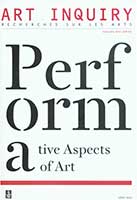On a performative artist and performative concept of an artist
On a performative artist and performative concept of an artist
Author(s): Grzegorz SztabińskiSubject(s): Fine Arts / Performing Arts
Published by: Łódzkie Towarzystwo Naukowe
Keywords: performing arts; performance art; performative turn in art; performative concept of artist; Joseph Beuys; Sophie Calle
Summary/Abstract: The term performative artist is usually applied to a person practicing one of the “performing arts” (such as music, theater, dance, etc.). Attempts have also been made to include happenings and performance art in this category. Some authors have emphasized the separateness of these phenomena, pointing, for example, to the “matrixed” activity of a theater actor and the “non-matrixed” behavior of a performer (M. Kirby) or the ongoing restoration of the limits of the actions (S. Gova). This prompted some representatives of the aesthetics of performativity (developing for over a decade) to treat these activities as a model for reflection on various artistic genres, including those which have been focused on artifacts. The “performative turn” consists in accentuating the practical aspect of the production of meanings, directing attention to the process of “displaying”, “staging”. The author of the article focuses on the changes in the understanding of the concept of an artist associated with that turn. Citing Judith Butler’s ideas on the performative development of gender, he poses the question of whether the establishment of a creative identity through a stylized repetition of acts also occurs in art, especially contemporary art. He points out that in both cases, the essentialist belief in the innate nature of human identity is rejected, which leads to the rejection of the expressive nature of actions. Their nature is performative and creates, rather than expresses, the self. Giving up the idea of natural determination also leads to emphasizing the possibility of transformation. Those issues are illustrated by a brief presentation of the ways in which Joseph Beuys and Sophie Calle shaped their artistic “selves”. The former exemplifies a model based on the universalization of the features previously associated only with art. Life itself is claimed to be a work of art, and everyone is viewed as potentially creative. In the second case, identity as the “locus of action” is given up in favor of an open process of becoming documented through performed works. Calle’s work gives the impression of someone else still deciding about her art, which is a departure from the essentialist and expression-oriented understanding of an artist’s activity.
Journal: Art Inquiry
- Issue Year: 2012
- Issue No: 14
- Page Range: 11-27
- Page Count: 17
- Language: English

